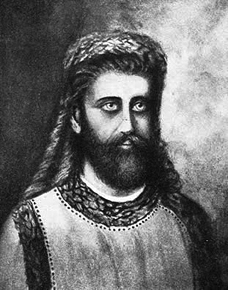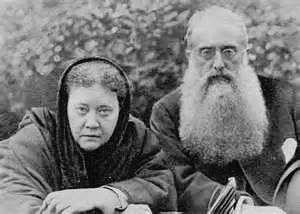|
|||
english version below
https://en.wikipedia.org/wiki/Talk:Helena_Blavatsky/Archive_1
Helena Paulowna Blavatsky, nata Helena Petrovna Hahn (1831-1891), teosofa russa, nata a Ekaterinoslav, Russia, 31 luglio (O.S.) 1831. Si afferma per essere stata la figlia di Peter Hahn, un ufficiale russo. Una ragazza ribelle, ha cercato l’emancipazione dai legami familiari, sposando nel suo 17° anno, il 7 luglio 1848, Nicephore Blavatsky, un ufficiale russo di stanza nel Caucaso, da cui si separa dopo pochi mesi di tempestosa vita coniugale. Nei giorni successivi, cerca di reinventarsi un alone di verginità, descrivendo il matrimonio come nominale, e il suo sposo come "un corvo senza piume più vicino ai settanta che ai sessanta". Se questa affermazione fosse vera, il Sig. Blavatsky, che fu segnalato come ancora in vita nel 1895, avrebbe dovuto avere più di 110 anni di età. Durante i venti anni che seguirono la separazione dal marito, la signora Blavatsky viaggiò acquisendo esperienza come medium spiritualista nelle grandi città, tra le quali si ritiene che abbia visitato Parigi, Il Cairo, New Orleans, Tokio, e Calcutta. Il periodo 1848-1858 è il periodo velato della sua vita, lei ha parlato vagamente di sette anni di permanenza nel "Piccolo Grande Tibet" o, preferibilmente, di un ritiro nell'Himalaya. Nel 1858 ritornò in Russia, dove ottenne un notevole successo come medium spiritualista. All'inizio degli anni Settanta acquisì importanza tra gli spiritualisti degli Stati Uniti, e fu coinvolta nelle frodi dei Fratelli Eddy e Katie King. Il suo tempo libero era occupato dallo studio della letteratura occulta e cabalistica, alla quale ben presto aggiunse anche gli scritti sacri dell'India, anche se dovette affrontarli per mezzo di traduzioni. Nel 1875 concepì il piano di combinare il controllo spiritico con le leggende buddhiste dei saggi tibetani. Da allora in poi decise di escludere tutto il controllo, salvo quello di due adepti tibetani o "mahatma", denominati rispettivamente Koot Hoomi e El Morya. I mahatma esposero i loro "corpi astrali" a lei, precipitandole messaggi che la raggiunsero dai confini del Tibet in un istante di tempo, le fornirono la sana dottrina e la incitarono ad eseguire trucchi per la conversione degli scettici. A New York, nel mese di ottobre del 1875, con l'aiuto del colonnello Olcott, lanciò la "Società Teosofica", che fu costituita da un gruppo di spiritualisti disillusi, e aveva tra i suoi scopi dichiarati di smontare lo spiritismo, per convertire i materialisti, e per dimostrare l'esistenza dei fratelli tibetani. Le letterature brahmaniche e buddhiste fornivano alla società con un vocabolario tecnico, e le sue dottrine erano una curiosa amalgama egiziana, cabalistica, occultista, indiana, e di idee spiritualistiche e formule moderne. I due principali libri di testo, Isis Unveiled (1877) e La Dottrina Segreta (1888), entrambi compilati da Madame Blavatsky, sono un mosaico di citazioni non riconosciute da opere ben note, come l’Enciclopedia Massonica di Mackenzie, Re gnostici, il Platone di Zeller, i lavori sulla magia di Dunlop, Salverte, Ennemoser, e Des Mousseaux, ma soprattutto dagli scritti mistici di Eliphas Levi. Soffrì molto su di un Glossario dei termini teosofici (1890-92), compilato a beneficio degli stupidi, come nei momenti di candore chiamava i suoi discepoli. Ma la comparsa di Home’s Lights and Shadows of Spiritualism (1877) ebbe un effetto pregiudizievole sulla sua fama, così Heliona P. Blavatsky (come cominciava a farsi conoscere) fu temporaneamente oscuriata in India. In seguito contribuì ad alcune intelligenti carteggi, “From the Cave and Jungles of Hindostan” al Russky Vyestnik. Sconfitta nel suo scopo di ottenere un impiego nel servizio segreto russo, riprese i suoi sforzi per la conversione alla teosofia. A tal fine si ritenne necessario mostrare dei "fenomeni fisici". I trucchi che praticava erano intelligentemente concepiti, ma eseguito con noncuranza, e in tre occasioni distinte l'elaborato sistema d’inganno a cui faceva ricorso venne scoperto nel modo più conclusivo. Tuttavia, la straordinaria bravura di Madame Blavatsky, la sua volubilità, energia e forza di volontà le hanno permesso di non soccombere e, quando morì, l’8 Maggio 1891, giorno del Loto Bianco, in Avenue Road,presso la sede Teosofica a Regent Park, Londra, era il capo riconosciuto di una comunità non lontana dai 100.000 membri, con riviste a Londra, Parigi, New York, e Madras. Molte informazioni rispettose saranno trovate in Solovyoff’s Modern Priestess of Isis, tradotto da B. Walter Leaf (1895), in Arthur Lillie Madame Blavatsky e la Teosofia (1895), e nella relazione fatta alla Società per la Ricerca Psichica dal laureato di Cambridge spedito per indagare sulle sue azioni in India. Nell’aspetto personale “the old one” come la signora era familiarmente chiamata dal suo seguito, veniva descritta di forma rotonda, con un colorito grigio opaco, lontana da una fisionomia attraente, e con gli occhi turchesi come scoloriti. Eppure, certamente affascinò coloro che venivano in contatto con lei, anche quelli, tra suoi colleghi, i quali erano in un continuo stato di disagio per le sue "bugie" e indiscrezioni.
Blavatsky, Helena Paulovna (1831-1891), Russian theosophist, was born at Ekaterinoslav, Russia, 31st July (O.S.) 1831. She is stated to have been the daughter of Peter Hahn, a Russian officer. An unruly girl, she sought emancipation from family ties by marrying in her 17th year (7th July 1848) Nicephore Blavatsky, a Russian official in Caucasia, from whom she was separated after a few months of stormy conjugal life. In later days, when seeking to invest herself with a halo of virginity, she described the marriage as a nominal one, and her bridegroom as “a plumeless raven nearer seventy than sixty.” If this statement were true, M. Blavatsky, who was reported as still living in 1895, would then have been considerably over 110 years of age. During the twenty years that followed the separation from her husband, Mme. Blavatsky travelled and probably gained experience as a spiritualistic medium in large cities, among which it is believed that she visited Paris, Cairo, New Orleans, Tokio, and Calcutta. The period 1848-58 was alluded to subsequently as the veiled period of her life, and she spoke vaguely of a seven years’ sojourn in “Little and Great Tibet” or preferably of a “Himalayan retreat.” In 1858 she revisited Russia, where she created a considerable sensation as a spiritualistic medium. Early in the 'seventies she acquired prominence among the spiritualists of the United States, and was mixed up in the Eddy Brothers and Katie King frauds. Her leisure was occupied with the study of occult and cabalistic literature, to which was soon to be added that of the sacred writings of India, though these had to be approached through the medium of translations. In 1875 she conceived the plan of combining the spiritualistic “control” with the Buddhistic legends about Tibetan sages or wonder-working adepts. Henceforth she determined to exclude all control save that of two Tibetan adepts or “mahatmas,” called respectively Koot Hoomi and Morya. The mahatmas exhibited their “astral bodies” to her, “precipitated” messages which reached her from the confines of Tibet in an instant of time, supplied her with sound doctrine, and incited her to perform tricks for the conversion of sceptics. At New York, in October 1875, with the aid of Colonel Olcott, she definitely launched the “Theosophical Society,” which was formed out of a group of disillusioned spiritualists, and had for its avowed objects to put down spiritualism, to convert the materialists, and to prove the existence of the Tibetan brothers. The Brahmanic and Buddhistic literatures supplied the society with a technical vocabulary, and its doctrines were a curious amalgam of Egyptian, cabalistic, occultist, Indian, and modern spiritualistic ideas and formulas. The two leading text-books, Isis Unveiled (1877) and The Secret Doctrine (1888), both compiled by Madame Blavatsky, are a mosaic of unacknowledged quotations from well-known works, as Mackenzie’s Masonic Cyclopaedia, King’s Gnostics, Zeller’s Plato, the works on magic by Dunlop, Salverte, Ennemoser, and Des Mousseaux, but above all from the mystical writings of Eliphas Levi. She took great pains with A Glossary of Theosophical Terms (1890-92), compiled for the benefit of the “flap-doodles,” as in moments of candour she called her disciples. But the appearance of Home’s Lights and Shadows of Spiritualism (1877) had a prejudicial effect upon the propaganda, and Heliona P. Blavatsky (as she began to style herself) sought temporary obscurity in India. Thence she contributed some clever papers, “From the Cave and Jungles of Hindostan,” to the Russky Vyestnik. Defeated in her object of obtaining employment in the Russian secret service, she resumed her efforts to gain converts to theosophy. For this purpose the exhibition of “physical phenomena” was found necessary. The jugglery which she practised was cleverly conceived, but carelessly executed, and on three distinct occasions the elaborate system of trickery to which she resorted was exposed in the most conclusive manner. Nevertheless, Madame Blavatsky’s extraordinary cleverness, volubility, energy, and will power enabled her to maintain her ground, and when she died on 8th May 1891 (White Lotus Day), at the Theosophical headquarters in Avenue Road, Regent’s Park, London, she was the acknowledged head of a community numbering not far short of 100,000, with journals in London, Paris, New York, and Madras. Much information respecting her will be found in Solovyoff’s Modern Priestess of Isis, translated b Walter Leaf (1895), in Arthur Lillie’s Madame Blavatsky and her Theosophy (1895), and in the report made to the Society for Psychical Research by the Cambridge graduate despatched to investigate her doings in India. In personal appearance the “old one,” as Madame was familiarly called by her following, has been described as globular in shape, with a dull gray complexion, a far from attractive physiognomy, and eyes like discolored turquoises. Yet she certainly fascinated those who came in contact with her, even those of her colleagues whom her “fibs” and indiscretions kept in a continual state of uneasiness. |
|||
| top |


